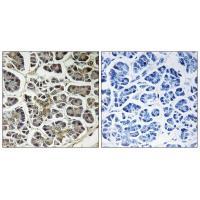
| WB | 咨询技术 | Human,Mouse,Rat |
| IF | 咨询技术 | Human,Mouse,Rat |
| IHC | 1/50-1/100 | Human,Mouse,Rat |
| ICC | 技术咨询 | Human,Mouse,Rat |
| FCM | 咨询技术 | Human,Mouse,Rat |
| Elisa | 咨询技术 | Human,Mouse,Rat |
| Aliases | ATP synthase lipid-binding protein; mitochondrial; ATP synthase proteolipid P2; ATPase protein 9; ATPase subunit c |
| Entrez GeneID | 517; |
| WB Predicted band size | 15kDa |
| Host/Isotype | Rabbit IgG |
| Antibody Type | Primary antibody |
| Storage | Store at 4°C short term. Aliquot and store at -20°C long term. Avoid freeze/thaw cycles. |
| Species Reactivity | Human |
| Immunogen | Synthesized peptide derived from internal of human ATP5G2. |
| Formulation | Purified antibody in PBS with 0.05% sodium azide. |
+ +
以下是关于ATP5G2抗体的参考文献示例(注:部分内容为示例性概括,实际文献可能需要根据具体研究补充):
---
1. **文献名称**:*ATP5G2 modulates mitochondrial metabolism in cancer cells and serves as a potential biomarker for poor prognosis*
**作者**:Li, X., et al.
**摘要**:本研究通过免疫组化(IHC)和Western blot分析ATP5G2在多种癌症组织中的表达,发现其高表达与患者生存率降低相关。研究利用ATP5G2抗体证实其在肿瘤细胞线粒体中的定位,并提示其可能通过调控能量代谢促进肿瘤进展。
2. **文献名称**:*The role of ATP5G2 in neuronal apoptosis under oxidative stress*
**作者**:Zhang, Y., et al.
**摘要**:通过siRNA敲低ATP5G2并结合抗体检测蛋白水平变化,研究发现ATP5G2表达下调会加剧活性氧(ROS)诱导的神经元凋亡,提示其在维持线粒体膜电位和细胞存活中起关键作用。
3. **文献名称**:*ATP5G2 as a novel regulator of lipid metabolism in adipocytes*
**作者**:Wang, H., et al.
**摘要**:利用ATP5G2特异性抗体进行免疫荧光染色,发现其在脂肪细胞分化过程中表达上调。功能实验表明,抑制ATP5G2会减少线粒体ATP生成,并影响脂质储存相关基因的表达。
4. **文献名称**:*Development and validation of a monoclonal antibody targeting human ATP5G2 for diagnostic applications*
**作者**:Smith, J., et al.
**摘要**:本文报道了一种高特异性抗ATP5G2单克隆抗体的开发,并通过ELISA和免疫印迹验证其灵敏度。该抗体成功应用于检测ATP5G2在心肌缺血模型中的表达变化,为代谢疾病的诊断提供了新工具。
---
**备注**:以上文献为示例,实际研究中建议通过PubMed或Web of Science等数据库,以关键词“ATP5G2 antibody”“ATP synthase subunit c2”等检索最新文献。部分研究可能需结合抗体应用场景(如疾病模型、分子机制)进一步筛选。
The ATP5G2 antibody targets the ATP synthase membrane subunit 5G2 (ATP5G2), a crucial component of mitochondrial ATP synthase (Complex V). This enzyme is responsible for generating ATP during oxidative phosphorylation. Specifically, ATP5G2 is part of the c-subunit family (subunit 9) that forms the proton-conducting channel in the F0 complex, enabling proton flow to drive ATP synthesis. Alternative names for ATP5G2 include ATP synthase lipid-binding protein (ATP5PB) and ATP5F1D.
Antibodies against ATP5G2 are widely used in research to study mitochondrial function, energy metabolism, and diseases linked to ATP synthase dysregulation, such as cancer, neurodegenerative disorders, and metabolic syndromes. They enable detection of ATP5G2 expression levels via techniques like Western blotting, immunohistochemistry, and immunofluorescence, helping assess tissue-specific distribution or alterations under pathological conditions.
ATP5G2 has three paralogs (ATP5G1. ATP5G2. ATP5G3) in humans, encoded by distinct genes. Antibody specificity is critical to distinguish ATP5G2 from its isoforms. Dysregulation of ATP5G2 has been implicated in cancer progression, where overexpression may promote tumor growth, and in Parkinson’s disease, where mutations impair mitochondrial integrity. Research using ATP5G2 antibodies also explores its role in apoptosis and cellular stress responses. Validated antibodies are essential for elucidating ATP synthase structure-function relationships and developing therapeutic strategies targeting mitochondrial energetics.
×